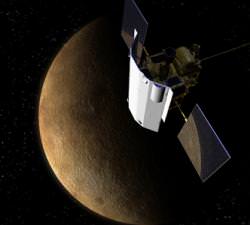If you thought you were good at pool, think again: in a game of interplanetary billiards, the MESSENGER team has guided its spacecraft to pass by Mercury for the first time on Monday, after a dizzying path that has already taken it past the Earth once and Venus twice.
The MESSENGER (Mercury Surface, Space Environment, Geochemistry and Ranging) spacecraft will make its very first flyby of the planet on January 14th at 2:04 EST. It will pass within 200 kilometers (124 miles) of the surface. During the flyby it will be taking images and scientific measurements of the planet’s features.
The data it will be taking this time around will complement the measurements it will make when finally in orbit. MESSENGER will map the composition of Mercury’s surface, capture images at a resolution of hundreds of meters, and measure the structure of the planet’s magnetosphere and magnetic and gravitational fields.
Monday’s flyby will be the first time a spacecraft has visited Mercury in 33 years, since Mariner 10 did a series of flybys in the mid-1970s. During that mission, the spacecraft only imaged one hemisphere of the planet. MESSENGER will complete the picture, so to speak, by taking close-up images for the very first time of the other hemisphere.
The flyby will allow the spacecraft to map several features of Mercury that it will not be able to measure when in orbit, such as the magnetotail – the drawn out tail of the planet’s magnetosphere as it travels through space. It will also take over 1,200 images of the planet.
MESSENGER was launched in August of 2004, and has been making its way to Mercury by a number of different flybys of the Earth and Venus. The journey, though, is far from over. The spacecraft will make two more flybys of Mercury in October 2008 and September 2009, finally settling into orbit of the planet in March 2011.
It will then start a yearlong comprehensive study with its seven scientific instruments. When the journey is over, it will have traveled 4.9 billion miles (7.9 billion kilometers).
For more information and photos of the flyby, visit the official MESSENGER website.
Source: Johns Hopkins University Applied Physics Laboratory Press Release


i’m curious how difficult it is to design a spacecraft that can travel that close to the sun?
Anyone know the closest any satellite has gone to the sun while still functioning?
what about SOHO? isnt that pretty close to the sun? i dont know.
Hi Gang,
try this…
http://www.astronautix.com/craft/helios.htm
While you are there have a good look at this site
Regards all
Martin
“what about SOHO? isnt that pretty close to the sun? i dont know.”
No, SOHO is not very close to the sun in relative terms. It moves in a ‘halo’ orbit at the so called L1 Lagrange point. The technical definition of that point isn’t overly important, but it lies only about 1% of the distance to the Sun from Earth, or 0.99 AU from the Sun.
As far as I’m aware, the two Helios spacecraft set the record for the closest encounter with the Sun. They came within 0.3 AU of the sun – slightly inside the orbit of Mercury, as Martin has mentioned.
@nick damski:
“i’m curious how difficult it is to design a spacecraft that can travel that close to the sun?”
It’s both in the design and spacecraft and mission brains. One of MESSENGER’s most distinctive features is its shield, which it keeps facing toward the sun at all times to protect the rest of the spacecraft from frying. Behind the shield, even when at Mercury’s solar distance temperatures should not get much above 30 C, and most of the instruments are designed to face temps a hotter than that for at least short periods. The kickers are very careful mission planning that restricts spacecraft motion to keep the shield pointed at the sun at all times, and spacecraft autonomy that will sense any accidental straying and act to correct it.
This is good (It should be, its NASA…) includes a short video clip
http://www.nasa.gov/mission_pages/messenger/main/index.html
Regards all
Martin
I remember the Helios mission from the old Blandford book on Unmanned Spaceflight and vaguly remember the mission, I’ll have to look in my collection and see if I have any New Scientist or newspaper cuttings from when Helios 2 came close to the sun in 1976.